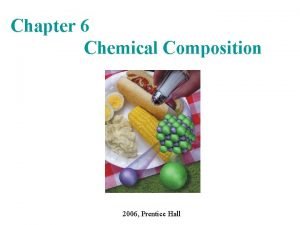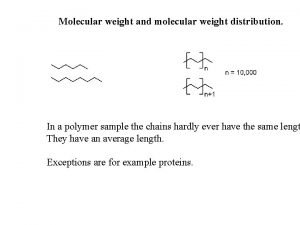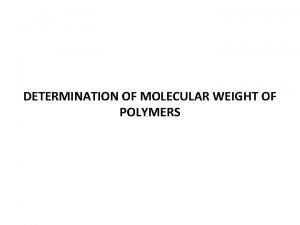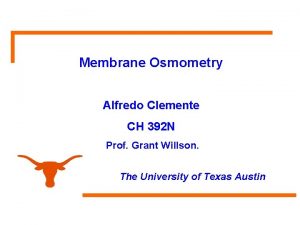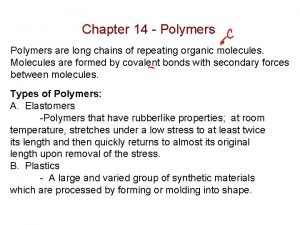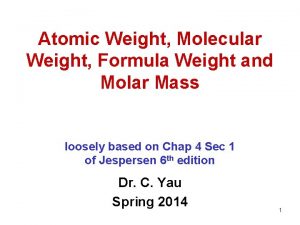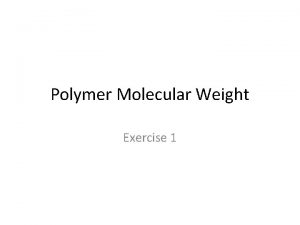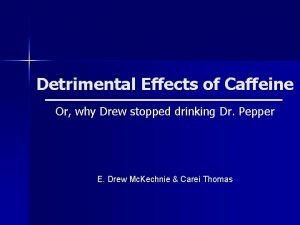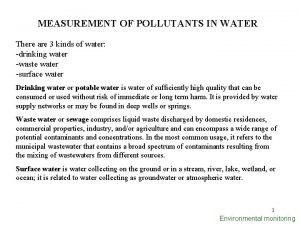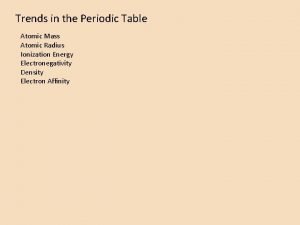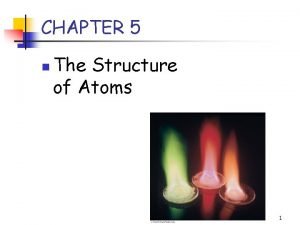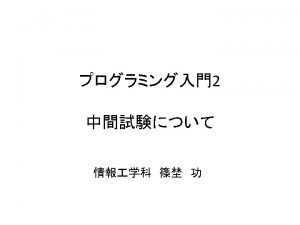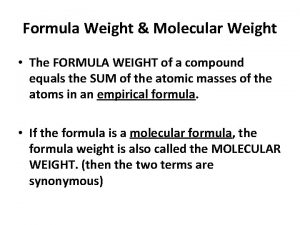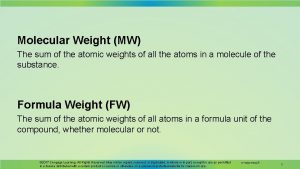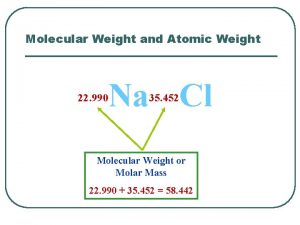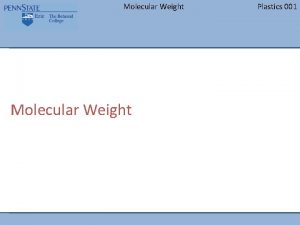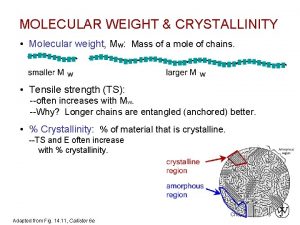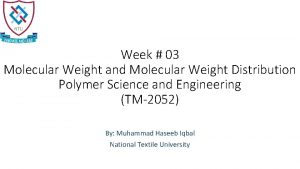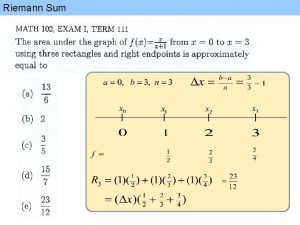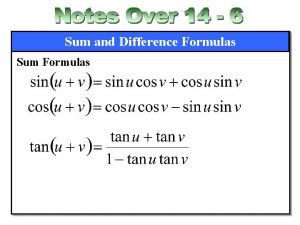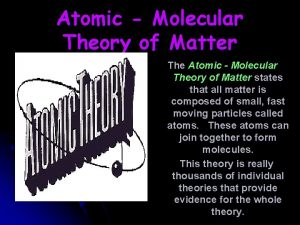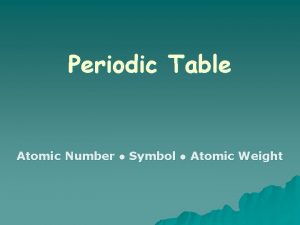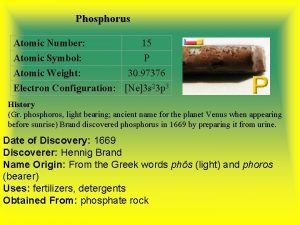Molecular Weight MW The sum of the atomic


























































- Slides: 58

Molecular Weight (MW) The sum of the atomic weights of all the atoms in a molecule of the substance. Formula Weight (FW) The sum of the atomic weights of all atoms in a formula unit of the compound, whether molecular or not. © 2017 Cengage Learning. All Rights Reserved. May not be copied, scanned, or duplicated, in whole or in part, except for use as permitted in a license distributed with a certain product or service or otherwise on a password-protected website for classroom use. סטויכיומטריה 3 - 1

Formula Weight Calculate the formula weight of the following compound using its atomic weight (AW). Chloroform, (CHCl 3) The answer rounded to three figures is 119 amu. סטויכיומטריה 3 - 2

Molecular Weight (MW) • A molecular weight is the sum of the atomic weights of the atoms in a molecule. • For the molecule ethane, C 2 H 6, the molecular weight would be C: 2(12. 011 amu) + H: 6(1. 00794 amu) 30. 070 amu סטויכיומטריה 3 - 3

Avogadro’s Number • In a lab, we cannot work with individual molecules. They are too small. • 6. 02 × 1023 atoms or molecules is an amount that brings us to lab size. It is ONE MOLE. • One mole of 12 C has a mass of 12. 000 g. © 2015 Pearson Education סטויכיומטריה 3 - Stoichiometry 4

Molar Mass • A molar mass is the mass of 1 mol of a substance (i. e. , g/mol). • The molar mass of an element is the atomic weight for the element from the periodic table. If it is diatomic, it is twice that atomic weight. • The formula weight (in amu’s) will be the same number as the molar mass (in g/mol). © 2015 Pearson Education סטויכיומטריה 3 - Stoichiometry 5

Amount of Substance: The Mole A counting unit – a familiar counting unit is a “dozen”: 1 dozen eggs 1 dozen peas = 12 eggs = 12 peas 1 mole (mol) = Number of atoms in 12 g of 12 C • Latin for “heap” or “pile” ערימה • 1 mol = 6. 02214179 x 1023 “units” • Avogadro’s number 1 mole eggs = 6. 02 x 1023 eggs 1 mole peas = 6. 02 x 1023 peas סטויכיומטריה 3 - 6

One-Mole Amounts S 8 X 8 = 256. 53 g סטויכיומטריה 3 - 7

Molecular mass vs Molar mass § Molecular mass § § mass of 1 molecule in amu Molar mass § mass of 1 mole in grams סטויכיומטריה 3 - 8

Molar Masses Note that the mass of water is included in the molar mass of a compound. סטויכיומטריה 3 - 9

Example • Acetylsalicylic acid (ASA), C 9 H 8 O 4, is the active ingredient of aspirin. What is the mass in grams of 0. 509 moles of ASA? • Analysis: • Information given moles of ASA (0. 509) formula of ASA C 9 H 8 O 4 • Information implied molar mass of ASA • Asked for mass of ASA • Strategy: • Substitute into the equation סטויכיומטריה 3 - 10


Flowchart for the Interconversion of Particles, Mass, and Moles סטויכיומטריה 3 - 12

Percentage Composition The mass percentage of each element in the compound. It helps determine the formula of new compounds. Mass Percentage Suppose that A is a part of something—that is, part of a whole. The mass percentage of A in a substance is the parts of A per hundred parts of the total, by mass. © 2017 Cengage Learning. All Rights Reserved. May not be copied, scanned, or duplicated, in whole or in part, except for use as permitted in a license distributed with a certain product or service or otherwise on a password-protected website for classroom use. סטויכיומטריה 3 - 3 | 13

Percentage Composition Determine the grams of carbon present in 83. 5 g CH 2 O. Use the following data: C = 40. 0 % H = 6. 73 % O = 53. 3 % Determining the mass of carbon in 83. 5 g CH 2 O, © 2017 Cengage Learning. All Rights Reserved. May not be copied, scanned, or duplicated, in whole or in part, except for use as permitted in a license distributed with a certain product or service or otherwise on a password-protected website for classroom use. סטויכיומטריה 3 - 3 | 14

Example • Metallic iron is most often extracted from hematite ore, which consists of iron(III) oxide mixed with impurities such as silicon dioxide, Si. O 2. What are the mass percents of iron and oxygen in iron(III) oxide? • Analysis: • Information given formula of the iron oxide (Fe 2 O 3) • Information implied molar mass (MM) of Fe 2 O 3 • Asked for mass % of Fe and O in Fe 2 O 3 סטויכיומטריה 3 - 15

Example • Strategy: • To find the mass percent of Fe follow the plan outlined below. Start with one mole of Fe 2 O 3 • Find the mass percent of oxygen by difference. Note that the compound is made up of only two elements, Fe and O סטויכיומטריה 3 - 16

Example • Solution: • Mass % Fe • Mass % O = 100 % - mass % Fe = 100 % – 69. 94 % = 30. 06 % סטויכיומטריה 3 - 17

Empirical Formula (Simplest Formula) The formula of a substance written with the smallest integer subscripts. For example, The empirical formula for H 2 O 2 is HO. Compound Mol. formula Emp. formula Hydrogen peroxide H 2 O 2 HO Borane (boron trihydride) BH 3 Diborane (diboron hexahydride) B 2 H 6 BH 3 Octene C 8 H 16 CH 2 Butene C 4 H 8 CH 2 © 2017 Cengage Learning. All Rights Reserved. May not be copied, scanned, or duplicated, in whole or in part, except for use as permitted in a license distributed with a certain product or service or otherwise on a password-protected website for classroom use. סטויכיומטריה 3 - 3 | 18

Determining the molecular formula requires: 1. The percentage composition 2. The molecular weight Determining the empirical formula for a substance involves converting the masses of the elements to moles. © 2017 Cengage Learning. All Rights Reserved. May not be copied, scanned, or duplicated, in whole or in part, except for use as permitted in a license distributed with a certain product or service or otherwise on a password-protected website for classroom use. סטויכיומטריה 3 - 3 | 19

A compound of nitrogen and oxygen is analyzed and a sample weighing 1. 587 g is found to contain 0. 483 g N and 1. 104 g O. Determine the empirical formula of the compound. © 2017 Cengage Learning. All Rights Reserved. May not be copied, scanned, or duplicated, in whole or in part, except for use as permitted in a license distributed with a certain product or service or otherwise on a password-protected website for classroom use. סטויכיומטריה 3 - 3 | 20

Converting masses to moles, Dividing the bigger mole number by the smaller one results in the smallest integers. N = 1. 00 O = 2. 00 As the ratio of N to O is 1: 2, the empirical formula is NO 2 © 2017 Cengage Learning. All Rights Reserved. May not be copied, scanned, or duplicated, in whole or in part, except for use as permitted in a license distributed with a certain product or service or otherwise on a password-protected website for classroom use. סטויכיומטריה 3 - 3 | 21

Determining molecular formula from empirical formula For any molecular compound, n is the number of empirical formula units in the molecule. Multiplying the subscripts of the empirical formula by n gives the molecular formula. © 2017 Cengage Learning. All Rights Reserved. May not be copied, scanned, or duplicated, in whole or in part, except for use as permitted in a license distributed with a certain product or service or otherwise on a password-protected website for classroom use. סטויכיומטריה 3 - 3 | 22

Determine the empirical formula and molecular formula of acetic acid using the following data. Percentage composition of acetic acid: C = 39. 9% H = 6. 72% O = 53. 4% Molecular weight of acetic acid = 60. 0 amu © 2017 Cengage Learning. All Rights Reserved. May not be copied, scanned, or duplicated, in whole or in part, except for use as permitted in a license distributed with a certain product or service or otherwise on a password-protected website for classroom use. סטויכיומטריה 3 - 3 | 23

100. 0 g of acetic acid contains 39. 9 g C, 6. 72 g H, and 53. 4 g O. Converting into moles gives: C = 3. 33 mol H = 6. 67 mol O = 3. 34 mol Dividing the mole numbers by the smallest one gives: C = 1. 00 H = 2. 00 O = 1. 00 The empirical formula of acetic acid is CH 2 O. © 2017 Cengage Learning. All Rights Reserved. May not be copied, scanned, or duplicated, in whole or in part, except for use as permitted in a license distributed with a certain product or service or otherwise on a password-protected website for classroom use. סטויכיומטריה 3 - 3 | 24

Empirical formula weight of CH 2 O is 30. 0 amu. Calculating the molecular formula of CH 2 O, The molecular formula of acetic acid is (CH 2 O)2 or C 2 H 4 O 2 © 2017 Cengage Learning. All Rights Reserved. May not be copied, scanned, or duplicated, in whole or in part, except for use as permitted in a license distributed with a certain product or service or otherwise on a password-protected website for classroom use. סטויכיומטריה 3 - 3 | 25

Determining the Formula of Hydrocarbon by Combustion • Combustion involves the addition oxygen to another element. • When hydrocarbon molecules burn completely, the products are always carbon dioxide gas and סטויכיומטריה 3 water. 26

Combustion Analysis Problem: • 1. 516 g of a compound containing carbon, hydrogen and oxygen (CXHYOZ) is subjected to combustion analysis. • The results show that 2. 082 g of CO 2 and 1. 705 g of H 2 O were produced. • What is the empirical formula for the compound? • If the molecular weight of the compound is 160. 2 g/mol, what is the molecular formula of the compound? סטויכיומטריה 3 - 27


Solution to the problem: g CO 2 mol C Don’t forget the mole ratio… g H 2 O mol H 2 O סטויכיומטריה 3 - mol H 29

Combustion Analysis Problem You can’t determine the oxygen in the sample from either CO 2 or H 2 O… Think about what is happening to the sample: Cx. Hy. Oz + O 2(g) CO 2(g) + H 2 O (l) The oxygen in the CO 2 and H 2 O came from both the sample and the O 2 in the furnace! Since there is no way to know how much of that oxygen came from the sample and the O 2, you cannot determine the oxygen in the sample directly! סטויכיומטריה 3 - 30

Combustion Analysis Problem original sample mass of C and H in sample סטויכיומטריה 3 - 31

Combustion Analysis Problem Collecting the results: yields CX HY O Z Both carbon and oxygen have the smallest numbers of mols: Divide each set of mols by 0. 04731. The empirical formula is: CH 4 O סטויכיומטריה 3 - 32

Combustion Analysis Problem Determining the Molecular Formula For some compounds, the molecular formula is a multiple of the empirical formula: formula empirical formula n x C X HY O Z molecular formula = Cn. XHn. YOn. Z n = 2, 3, 4… Since the molecular formula is a multiple is scaled by a factor “n”, the molecular and empirical molar masses must also scale by the same ratio. סטויכיומטריה 3 - 33

Combustion Analysis Problem From the combustion analysis it was found that the empirical formula for the unknown compound was CH 4 O. This yields an empirical molar mass or empirical weight of: [12. 01 + 4 x(1. 0079) +16. 00] g/mol = 32. 04 g/mol סטויכיומטריה 3 - 34

Stoichiometry The calculation of the quantities of reactants and products involved in a chemical reaction. Interpreting a Chemical Equation A chemical equation may be interpreted in terms of either: (1) Numbers of molecules (or ions or formula units) or (2) Numbers of moles © 2017 Cengage Learning. All Rights Reserved. May not be copied, scanned, or duplicated, in whole or in part, except for use as permitted in a license distributed with a certain product or service or otherwise on a password-protected website for classroom use. סטויכיומטריה 3 - 3 | 35

Representing Chemistry on Different Levels 2 H 2(g) + O 2(g) Microscopic: 2 H 2 O(l) 2 molecules of hydrogen gas react with 1 molecule of oxygen gas to yield 2 molecules of liquid water. Physical states are often listed: (g) (ℓ) gas liquid (s) solid (aq) aqueous (dissolved in water) סטויכיומטריה 3 - 3 | 36

Why Do We Add Coefficients Instead of Changing Subscripts to Balance? • Hydrogen and oxygen can make water OR hydrogen peroxide: Ø 2 H 2(g) + O 2(g) → 2 H 2 O(l) Ø H 2(g) + O 2(g) → H 2 O 2(l) סטויכיומטריה 3 - 3 | 37

Chemical Equations Any equation can be interpreted as referring to the nanoscale or macroscale: Na. HCO 3(s) + HCl(aq) → CO 2(g) + H 2 O(ℓ) + Na. Cl(aq) 1 formula unit + 1 molecule → 1 molecule + 1 form. unit 4 form. units + 4 molecules → 4 molecules + 4 form. units NA form. units + NA molecules → NA molecules + NA form. units 1 mol + 1 mol → 1 mol + 1 mol סטויכיומטריה 3 - 3 | 38

Steps in a stoichiometric calculation סטויכיומטריה 3 - 3 | 39

Consider the following reaction and determine the grams of iron that can be produced from 1. 00 kg of Fe 2 O 3. סטויכיומטריה 3 - 3 | 40

Determine the grams of HCl that react with 5. 00 g of manganese dioxide according to the following reaction. סטויכיומטריה 3 - 3 | 41

Limiting Reactant מגיב מגביל The reactant that is entirely consumed when a reaction goes to completion. Once one reactant has been completely consumed, the reaction stops. The moles of product are always determined by the starting moles of the limiting reactant. סטויכיומטריה 3 - 3 | 42

Limiting Reactant Given 10 slices of cheese and 14 slices of bread. How many sandwiches can you make? Balanced equation 1 cheese + 2 bread 1 sandwich 1 cheese ≡ 2 bread 1 cheese ≡ 1 sandwich 2 bread ≡ 1 sandwich 3/43

Limiting Reactant Bread is limiting… …base all other calculations on the limiting reactant. Sandwiches made 14 bread x 1 sandwich = 7 sandwiches 2 bread Cheese remaining 14 bread x 1 cheese = 7 cheese used 2 bread Initially Used Excess cheese = 10 – 7 = 3 slices 3/44

Limiting Reactants • The limiting reactant is the reactant present in the smallest stoichiometric amount. – In other words, it’s the reactant you’ll run out of first (in this case, the H 2). © 2015 Pearson Education סטויכיומטריה 3 - Stoichiometry 45

Limiting Reactants In the example below, the O 2 would be the excess reagent. עודף © 2015 Pearson Education סטויכיומטריה 3 - Stoichiometry 46

Limiting Reactant • 2 Sb (s) + 3 I 2 (s) → 2 Sb. I 3 (s) Copyright © 2016 Cengage Learning. All Rights Reserved. סטויכיומטריה 3 - 3 | 47

Example • Consider the reaction • What is the limiting reactant when 1. 20 mol of Sb and 2. 40 mol of I 2 are mixed? • Analysis: • Information given • Asked for moles of each reactant: Sb (1. 20), I 2 (2. 40) balanced equation limiting reactant Copyright © 2016 Cengage Learning. All Rights Reserved. סטויכיומטריה 3 - 3 | 48

Example • Strategy: • Find mol Sb. I 3 produced by first assuming Sb is limiting, and then assuming I 2 is limiting • mol Sb → mol Sb. I 3; mol I 2 → mol Sb. I 3 • The reactant that gives the smaller amount of Sb. I 3 is limiting. Copyright © 2016 Cengage Learning. All Rights Reserved. סטויכיומטריה 3 - 3 | 49

Example • Solution: • mol Sb. I 3 • Limiting reactant • 1. 20 mol (Sb limiting) < 1. 60 mol (I 2 limiting); the limiting reactant is Sb. Copyright © 2016 Cengage Learning. All Rights Reserved. סטויכיומטריה 3 - 3 | 50

Limiting Reactant Mole Ratio Method Calculate the amount (mol) of two reactants and then their mole ratio. If: actual < theoretical: numerator reactant is limiting. actual > theoretical: numerator reactant is in excess. Example If 374 g of NH 3 and 768 g of O 2 are mixed, what mass of NO will form? 4 NH 3(g) + 5 O 2(g) → 4 NO(g) + 6 H 2 O(g) 3/51

Limiting Reactant 374 g NH 3 + 768 g O 2, mass. NO formed? 4 NH 3 + 5 O 2 → 4 NO + 6 H 2 O Balanced? Yes 1 mol n. NH 3 = 374 g 17. 03 g = 21. 96 mol 1 mol n. O 2 = 768 g = 24. 00 mol 32. 00 g Mole ratio of reactants 24. 00 actual = 1. 093 21. 96 5 theoretical = 1. 25 4 actual < theo. O 2 is limiting 3/52

Limiting Reactant Mass of NO formed? 4 NH 3(g) + 5 O 2(g) → 4 NO(g) + 6 H 2 O(g) excess 24. 00 mol ? O 2 is limiting. Base all calculations on O 2. 4 NO n. NO = 24. 00 mol O 2 = 19. 20 mol 5 O 2 mass. NO = 19. 20 mol 30. 01 g = 576 g 1 mol 3/53

ניצולת Theoretical Yield The maximum amount of product that can be obtained by a reaction from given amounts of reactants. This is a calculated amount. © 2017 Cengage Learning. All Rights Reserved. May not be copied, scanned, or duplicated, in whole or in part, except for use as permitted in a license distributed with a certain product or service or otherwise on a password-protected website for classroom use. סטויכיומטריה 3 - 3 | 54

Actual Yield The amount of product that is actually obtained. This is a measured amount. Percentage Yield © 2017 Cengage Learning. All Rights Reserved. May not be copied, scanned, or duplicated, in whole or in part, except for use as permitted in a license distributed with a certain product or service or otherwise on a password-protected website for classroom use. סטויכיומטריה 3 - 3 | 55

Percent Yield Few chemical reactions have 100% yield. Possible reasons Side reactions may produce undesired product(s). Incomplete reaction due to poor mixing or reaching equilibrium… Product loss during isolation and purification. © 2017 Cengage Learning. All Rights Reserved. May not be copied, scanned, or duplicated, in whole or in part, except for use as permitted in a license distributed with a certain product or service or otherwise on a password-protected website for classroom use. סטויכיומטריה 3 - 3 | 56

Percent Yield 2. 50 g of copper heated with an excess of sulfur made 2. 53 g of copper(I) sulfide 16 Cu(s) + S 8(s) → 8 Cu 2 S(s) What was the percent yield for this reaction? 1 mol = 0. 03934 mol Cu n. Cu used: 2. 50 g 63. 55 g Theoretical yield 16 Cu ≡ 8 Cu 2 S 0. 03934 mol Cu 8 Cu 2 S = 0. 01967 mol Cu 2 S 16 Cu © 2017 Cengage Learning. All Rights Reserved. May not be copied, scanned, or duplicated, in whole or in part, except for use as permitted in a license distributed with a certain product or service or otherwise on a password-protected website for classroom use. סטויכיומטריה 3 - 3 | 57

Percent Yield 2. 50 g Cu + S 8 (excesss) made 2. 53 g Cu 2 S… What was the %-yield? Theoretical yield (0. 01967 mol Cu 2 S) = 0. 01967 mol Cu 2 S 159. 2 g = 3. 131 g Cu 2 S 1 mol Actual yield = 2. 53 g Cu 2 S (in problem) 2. 53 g Percent yield = x 100% = 80. 8% 3. 131 g © 2017 Cengage Learning. All Rights Reserved. May not be copied, scanned, or duplicated, in whole or in part, except for use as permitted in a license distributed with a certain product or service or otherwise on a password-protected website for classroom use. סטויכיומטריה 3 - 3 | 58
 Giant molecular structure vs simple molecular structure
Giant molecular structure vs simple molecular structure Giant molecular structure vs simple molecular structure
Giant molecular structure vs simple molecular structure Covalent bond melting point
Covalent bond melting point Molar mass of naoh
Molar mass of naoh Number-average molecular weight
Number-average molecular weight End group analysis
End group analysis Molecular weight distribution of polymers
Molecular weight distribution of polymers Membrane osmometry molecular weight
Membrane osmometry molecular weight Molecular weight units
Molecular weight units Tincture of orange is prepared by
Tincture of orange is prepared by Molecular weight unit
Molecular weight unit Number molecular weight
Number molecular weight Caffeine has a molecular weight of 194
Caffeine has a molecular weight of 194 Atomic elements vs molecular elements
Atomic elements vs molecular elements Catalysis lecture notes
Catalysis lecture notes Atomic molecular theory
Atomic molecular theory Difference between atomic and molecular spectroscopy
Difference between atomic and molecular spectroscopy How is orbital hybridization useful in describing molecules
How is orbital hybridization useful in describing molecules Tolerable weight is a body weight
Tolerable weight is a body weight Bulk reducing meaning
Bulk reducing meaning Mass of oxygen
Mass of oxygen Unit for avogadro's number
Unit for avogadro's number Atomic mass trend
Atomic mass trend Moles of atoms
Moles of atoms Atomic weight scale
Atomic weight scale Atomic weight units
Atomic weight units Atomic weight
Atomic weight Relative formula mass of hcl
Relative formula mass of hcl Atomic
Atomic Periodic table trend
Periodic table trend Atomic number vs atomic radius
Atomic number vs atomic radius Atomic radius in a periodic table
Atomic radius in a periodic table Sum0
Sum0 Môn thể thao bắt đầu bằng chữ đua
Môn thể thao bắt đầu bằng chữ đua Khi nào hổ con có thể sống độc lập
Khi nào hổ con có thể sống độc lập Hình ảnh bộ gõ cơ thể búng tay
Hình ảnh bộ gõ cơ thể búng tay Dạng đột biến một nhiễm là
Dạng đột biến một nhiễm là Nguyên nhân của sự mỏi cơ sinh 8
Nguyên nhân của sự mỏi cơ sinh 8 Trời xanh đây là của chúng ta thể thơ
Trời xanh đây là của chúng ta thể thơ độ dài liên kết
độ dài liên kết Voi kéo gỗ như thế nào
Voi kéo gỗ như thế nào Thiếu nhi thế giới liên hoan
Thiếu nhi thế giới liên hoan Phối cảnh
Phối cảnh điện thế nghỉ
điện thế nghỉ Một số thể thơ truyền thống
Một số thể thơ truyền thống Thế nào là hệ số cao nhất
Thế nào là hệ số cao nhất Ng-html
Ng-html Sơ đồ cơ thể người
Sơ đồ cơ thể người Bảng số nguyên tố lớn hơn 1000
Bảng số nguyên tố lớn hơn 1000 đặc điểm cơ thể của người tối cổ
đặc điểm cơ thể của người tối cổ Các châu lục và đại dương trên thế giới
Các châu lục và đại dương trên thế giới Chụp tư thế worms-breton
Chụp tư thế worms-breton ưu thế lai là gì
ưu thế lai là gì Thẻ vin
Thẻ vin Tư thế ngồi viết
Tư thế ngồi viết Bàn tay mà dây bẩn
Bàn tay mà dây bẩn Các châu lục và đại dương trên thế giới
Các châu lục và đại dương trên thế giới Mật thư anh em như thể tay chân
Mật thư anh em như thể tay chân Bổ thể
Bổ thể



